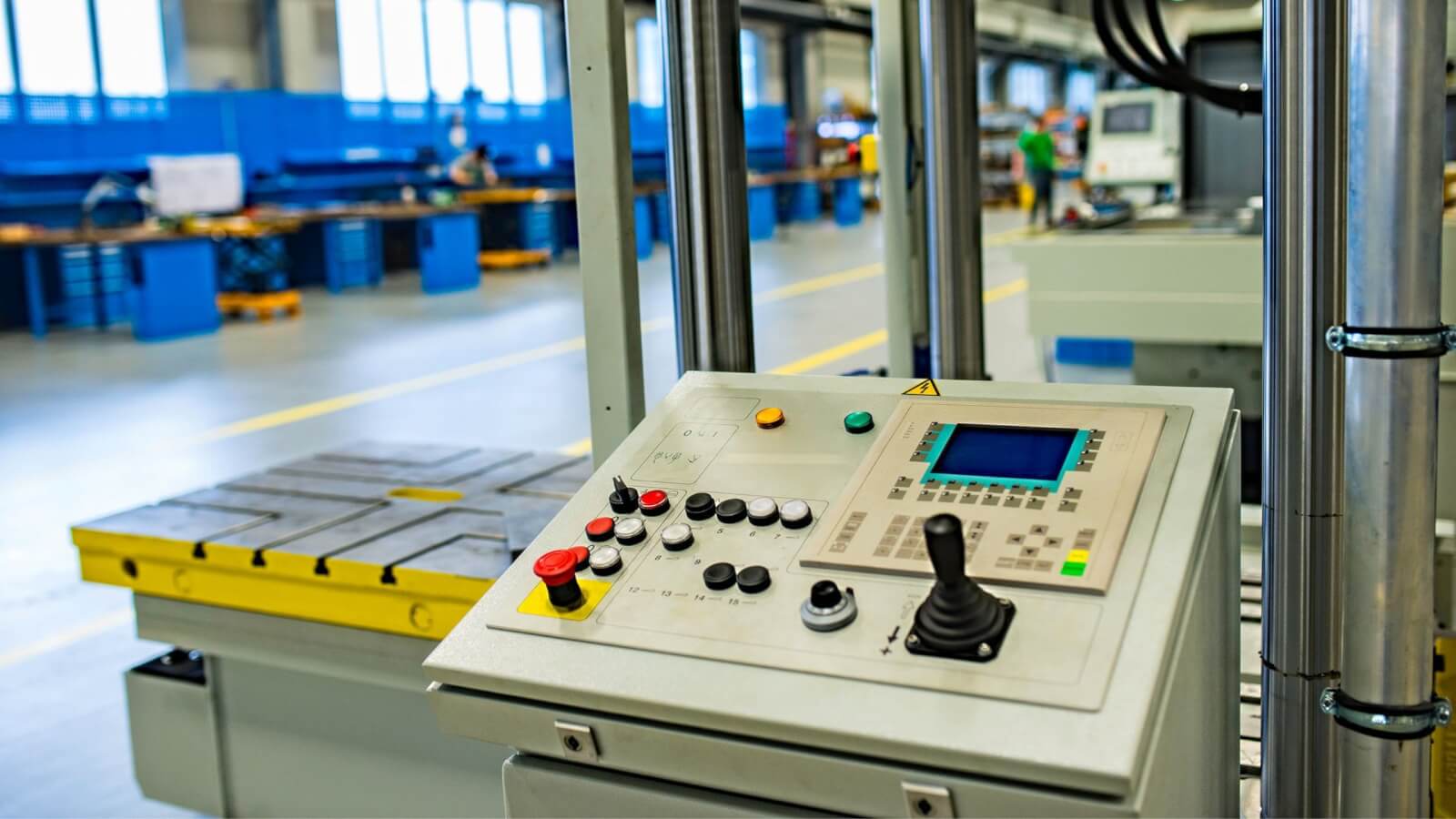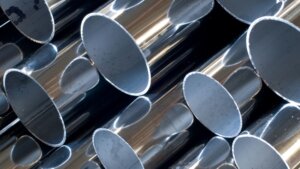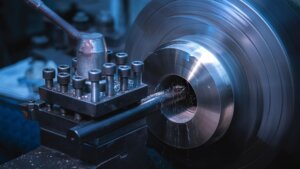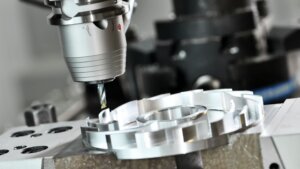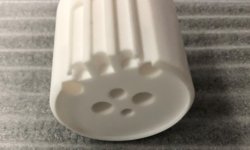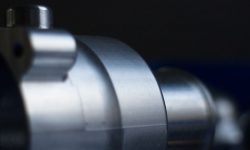Stainless steel is one of the most commonly used machining materials. Stainless steel machining creates products and tools for every sector out there.
Stainless steel machining is not as easy as materials like wood. Stainless steel has a high hardness and tensile strength. Therefore, machining stainless steel requires understanding the different metalworking processes that work well on this material.
This article will discuss the different grades of stainless steel and the methods to machine them. It will also provide several tips to make stainless steel machining the easiest metalworking process.
What is Stainless Steel?
Stainless steel is an alloy of Iron and Chromium. Other elements like Carbon can also be added to get some particular properties. The amount of Chromium is at least 11%.
Iron has excellent physical properties like strength and durability. However, it is highly prone to corrosion and abrasions. Adding Chromium to iron adds the ability to resist corrosion and abrasions.
Can Stainless Steel Be Machined?
Yes, stainless steel can be machined. In fact, there are many different ways of stainless steel machining. Machining stainless steel can be quite easy once you understand the properties of stainless steel and the right machining methods to use.
Types of Stainless Steel
Stainless steel is a wide class of a number of materials. Many believe that stainless steel is one particular alloy, which is wrong. There are more than 150 grades of Stainless Steel. These different stainless steels are divided into various classes.
Let us explore the five classes of stainless steels one by one:
Austenitic Stainless Steels
Austenitic stainless steel is the most popular variety among all stainless steels. These steels are named so because they have an Austenite structure. Austenitic stainless steels are non-magnetic in nature. Additionally, they cannot be hardened by heat treatment. These properties are derived by elements like Nickel, Manganese, and Nitrogen.
Austenitic stainless steels are divided into two subgroups: AISI 200 and AISI 300. Sometimes, molybdenum is added to these steels to increase corrosion resistance.
Examples of Austenitic Stainless Steels
- Type 304
- Type 316
- Alloy 20 (Carpenter 20)
- Type 321H
- Type 309S
Properties of Austenitic Stainless Steel
- Corrosion Resistance: Very high
- Heat Treatable: No
- Magnetic: Non-magnetic
- Toughness: Very high
- Ductility: Very high
- Welding Ability: High
- Chromium Content: 18% on average
- Nickel Content: Usually 8% to 12%
- Molybdenum Content: 2% to 7%
- Carbon Content: Less than 0.1%
- Stress Corrosion Cracking: Low resistance
Applications of Austenitic Stainless Steel
- 200 Stainless Steel Grades are used for household products like washing machines, automobiles, architecture, water tanks, and dishwashers.
- 300 Stainless Steel Grades make aerospace components, pharmaceutical products, mining industry tools, cutlery, and storage equipment.
Ferritic Stainless Steels
Ferritic stainless steels were discovered early in history (1912). However, it wasn’t until the 1980s that their popular applications took place. Ferritic stainless steels belong to the AISI 400 family.
Ferritic stainless steels don’t shine among other steels in terms of physical properties. However, they have exceptional quality in magnetic properties and chemical resistance. Ferric steel’s strength lies in its resistance to stress corrosion cracking.
Examples of Ferritic Stainless Steel
- Type 405
- Type 409L
- Type 410L
- Type 430
- Type 439
- Type 447
Properties of Ferritic Stainless Steel
- Corrosion Resistance: Very high
- Heat Treatable: No
- Magnetic: Magnetic
- Toughness: Medium
- Ductility: Medium
- Welding Ability: Low
- Chromium Content: 10.5% to 30%
- Nickel Content: Usually nickel-free
- Molybdenum Content: Usually 1% to 2%
- Carbon Content: Less than 0.08%
- Stress Corrosion Cracking: High resistance
Applications of Ferritic Stainless Steels
- Ferritic stainless steels find applications in making kitchenware, automotive parts, and industrial tools.
Martensitic Stainless Steels
Martensitic stainless steels are named after Adolf Martens. These steels are known for their exceptionally high hardness. Aging and heat treatments apply to these steels for high hardness and tempering. Martensitic stainless steels can have high carbon quality or low carbon quality.
Examples of Martensitic Stainless Steels
- X12Cr13
- X20Cr30
- X50CrMoV15
- X17CrNi16-2
Properties of Martensitic Stainless Steels
- Corrosion Resistance: High
- Heat Treatable: Yes
- Magnetic: Mostly magnetic, some non-magnetic
- Toughness: Low for untempered, high for tempered
- Ductility: High
- Welding Ability: High
- Chromium Content: 12% to 17%
- Nickel Content: Usually nickel-free, sometimes 2% to 4%
- Molybdenum Content: Nil to 1%
- Carbon Content: 0.1% to 1.2%
- Stress Corrosion Cracking: Poor resistance
Applications of Martensitic Stainless Steels
Martensitic grades are used for surgical instruments, dental equipment, door beams, bumpers, firearms, cutlery, and ball bearings.
Duplex Stainless Steels
Duplex stainless steels have two structural components in their design. Duplex alloys are a combination of austenitic stainless steels and ferritic stainless steels. Duplex stainless steels improve the qualities of these two constituent structural elements. There are three grades in duplex stainless steel: standard duplex, super duplex, and lean duplex alloys.
Example of Duplex Stainless Steel
- X2CrNiN22-2
- X2CrCuNiN23-2-2
- X2CrNiMoSi18-5-3
- X2CrMnNiMoN21-5-3
- X2CrNiMoCuN25-6-3
- X2CrNiCuN23-4
Properties of Duplex Stainless Steel
- Corrosion Resistance: Good to Very High
- Heat Treatable: Yes
- Magnetic: Magnetic due to the presence of ferritic structure
- Toughness: High
- Ductility: Medium to High
- Welding Ability: High if they contain Nitrogen
- Chromium Content: 18% to 30%
- Nickel Content: 1% to 9.5%
- Molybdenum Content: 0.1% to 5%
- Carbon Content: None
- Stress Corrosion Cracking: Very high resistance
Application of Duplex Stainless Steel
Duplex stainless steels are used for heat exchangers, tubes, shells, columns, condensers, reactors, piping systems, and other commercial equipment.
Precipitation Hardening Stainless Steels
Precipitation Hardening stainless steels are also known as PH stainless steel alloys. These alloys have slight additions of elements like titanium, copper, phosphorus, or aluminum. After the formation of alloy, these steels undergo age-hardening treatment. Precipitation hardening stainless steels can have 3-4x the yield strength of austenitic stainless steel.
Example of Precipitation Hardened Stainless Steels
- 17-4 PH Steel
Properties of Precipitation Hardened Stainless Steels
The properties of PH hardened steels are highly variable and specially curated to get the desired results.
Applications of Precipitation Hardening Stainless Steel
PH hardened steels find applications in extremely high strength requirements. Common examples are marine construction, aircraft, nuclear plants, and the chemical industry.
Stainless Steel Machining Processes
Stainless steel can undergo a range of different machining processes. Some of these processes are:
Milling
Milling is the most common primary stainless steel machining process. It uses high-speed rotating cutting tools for a stationary workpiece. Choosing the right tool when using milling machines on stainless steel alloys is important. Wrong tools or high speeds can result in rapid tool wear. Milling stain steel has a very high accuracy and a smooth cutting edge.
Turning
Turning requires a stationary cutting tool and a rotating workpiece. The tool comes in physical contact with the rotating workpiece to remove material. Turning is a common process for machining austenitic stainless steel. It is important to keep tool overhang minimum when machining stainless steels.
Drilling
Drilling is a secondary machining process used in conjunction with other metalworking techniques. Drilling is done to create holes in the metal workpiece. Stainless steels are drilled for screw holes, secondary assembly, or aesthetics.
Threading
Threading is done on steel parts for mounting screws and fasteners. The threads can be inside a hole or the exterior of the workpiece. Threading on stainless steel are usually carried on pipes and tubes.
Laser Cutting
Laser cutting uses an amplified light beam for melting and removing stainless steel. This method only works for thin sheets of stainless steel. It is better than cemented carbide tools because tool wear doesn’t occur. However, it is very expensive and requires highly skilled labor.
Grinding
Grinding is done to enhance the surface finish of the stainless steel. It can also make the workpiece more accurate by removing material in very low volume. Grinding rubs abrasive wheels against stainless steel workpieces. This process can also remove the burrs created due to welding. Grinding can help in creating a smooth cutting edge on stainless steel parts.
EDM (Electrical Discharge Machining)
Electrical Discharge Machining (EDM) uses electrical pulses to melt the metal. The electrical pulses have a very high voltage and frequency. This process is limited in terms of stainless steel cutting thickness.
Waterjet Cutting
Waterjet cutting uses the force of high-pressure water for material erosion and cutting. This process can cut thick sheets of stainless steel. However, if the particular stainless steel grade has low corrosion resistance, waterjet cutting can cause adverse effects.
Is Stainless Steel Difficult to Machine?
Stainless steel can have some difficulties during machining. These difficulties are common in most machining processes. However, with certain precautions, the issues with machining stainless steel can be avoided.
The primary issue arises due to overheating of the steel surface. Overheating is commonly encountered during any machining process. In the case of stainless steel alloy, overheating compromises the corrosion resistance of the materials. However, overheating can be avoided by monitoring the workpiece. Stainless steel shows tinted colors on the surface when heated.
This heat reaction is fixed with the process of pickling. Pickling involves treating stainless steel with hydrochloric or sulfuric acid. The acid dissolves the oxidation layer from the steel, restoring the alloy’s corrosion resistance.
Issues With Machining Stainless Steel
Some secondary difficulties that occur in machining stainless steel are:
- Stainless steel causes high tool wear and decreases tool life.
- It requires a high force to provide the required results.
- Machining operations on stainless steel have poor chip control.
- Some stainless steel grades have exceptionally high hardness.
Which Stainless Steels are Difficult to Machine?
Every steel variety can give a certain degree of trouble during machining. However, some steels are more problematic in this regard than others. Here are some of the difficult-to-machine steels and the trouble they give:
High Carbon Steel
High carbon steels are difficult to machine due to their extremely high strength and hardness. Additionally, these steels contain carbide-grade materials in them. These factors wear out the tools quite fast.
Low Carbon Steel
Low-carbon alloys can also prove to be difficult to machine. This is because of the high softness of these steels. The softness results in the adhesion of steel chips to the cutting tools. This shortens the tool life as well.
316 Stainless Steel
316 stainless steel has one of the poorest machinability rating. It requires specialized cutting tools for machining. Therefore, 316 stainless steel is used for parts when no other option will work.
304 Stainless Steel
The problem with 304 stainless steel is work hardening. 304 shows properties of rapid work hardening during machining. This problem is resolved by adding sulfur to the workpiece.
Which is the Easiest Stainless Steel to Machine?
416 stainless steel is the easiest to machine. In practice, machining of 400 series stainless steel grades is quite easy. On the other hand, machining 300 series stainless steel grades is difficult.
Tips to Ease Stainless Steel Machining
Stainless steel machining can be made easy by incorporating the following tips:
Prefer High-Quality Materials
Use the best quality workpiece materials for the smoothest operations. There are many grades of stainless steel. Within each grade, there are multiple quality options. Spending a little extra early on can help in saving significant cost and tool breakage hassle.
Work Hardening
Work hardening is the phenomenon where stainless steel gets harder during machining. This occurs due to the plastic deformation of stainless steel. Work hardening significantly increases the difficulty in machining stainless steels. However, hardening can be decreased by feeding coolant to the cutting tool.
Rigid Tooling
The tool connections and the machine setup should be extremely tight. Any tool chatter gets amplified and results in poor machining. Additionally, the machine bed should not have excessive vibration after workpiece fittings.
Tool Material
Selecting the right tool material is essential to get a high-quality result. Two common options for making tools are cemented carbide and high-speed steel.
High-speed steel is commonly used in drill bits and power saws. These tools are made to handle high movement speeds. Cemented carbide tools are made with Tungsten Carbide, Titanium Carbide, or Tantalum Carbide.
Carbide tooling is faster than high-speed steels. In addition, carbide tools provide a better finish. This makes them ideal for mass production and high cutting speeds. However, high-speed steels are considerably cheaper.
Use Sharp Tooling
Ensure that you have sharp tooling for consistent and precise machining. It is better to replace worn-out tools. Using blunt tools can cause tool breakage and even ruin the workpiece material. When working on steel, tools also require honing of the sharp edges.
Lubricants
Using a lubricant while machining stainless steels is essential. Lubrication serves multiple uses for machining. Firstly, it reduces the friction between the cutting tool and the metal. This increases tool life by reducing the wear of the tooling. Secondly, lubrication reduces the temperature during the machining process. This reduces the work hardening and overheating problems. Lastly, lubrication fluids also wash away the stainless steel residue from the workpiece and the tools.
What are the Advantages of Stainless Steel?
Using stainless steel has a lot of benefits. The benefits significantly outweigh any difficulties faced in the machining process. Here are a few of these benefits:
- The primary advantage of stainless steel is its corrosion resistance. Unlike iron, stainless steel does not catch rust, regardless of the moisture content of the environment.
- With the proper tools, it is easy to mold, cut, join, and/or weld stainless steel into any required shape.
- There are multiple surface finish options available for stainless steel material. It is the major requirement for aesthetic appeal.
- Stainless steel is very hygienic. This makes it applicable to the food industry and surgical equipments.
- The physical characteristics of this material are exceptional.
- It is very durable and lasts for a long time without issues.
- It is completely recyclable.
Are There Any Disadvantages to Stainless Steel for Machining?
There can be certain factors regarding stainless steels that can be disadvantageous to some users. These factors are:
- Stainless steel is expensive.
- It is easy to dent.
- Many grades of stainless steel easily catch scratches.
What is the Cheapest Stainless Steel for Machining?
Type 409 is the cheapest grade of steel. Steels belonging to the ferritic family are generally cheaper. This is because of the reduced chromium content in these steels. Chromium is the major driving factor in steel cost.
Best Stainless Steel Machining Services
3ERP is the global leader when it comes to stainless steel machining services. It provides a range of stainless steel machining services. Some of the popular offerings of 3ERP are CNC machining, rapid tooling, and sheet metal prototyping.
The best part when working with 3ERP is the ease of production. You can provide your designs to 3ERP. 3ERP then creates the design with the in-house machinery. The machinery itself is the best in terms of quality and features. Therefore, you get advanced machining capabilities without paying for the equipment itself.
Endnotes
Stainless steel products are the preferred choice for many industries. Machine parts, in particular, are made using this material due to its rugged and corrosion-resistant nature. If you want to use stainless steel for your next project, get in touch with 3ERP to find the exact quotes.
Frequently Asked Questions (FAQs)
Here are the answers to some common questions regarding machining stainless steels:
Is stainless steel hard to mill?
Stainless steel is not that hard to mill. However, it requires expertise and the right tool selection. The expertise helps in ensuring correct cutting speeds and tight setups.
What is the most common machined stainless steel?
Grade 304 is the most commonly machined stainless steel. It is because of the popular demand for this steel. Grade 304 steel has high corrosion resistance and durable nature. Additionally, it has a very ductile, tough, and weldable material. This leads to countless uses throughout different applications.
